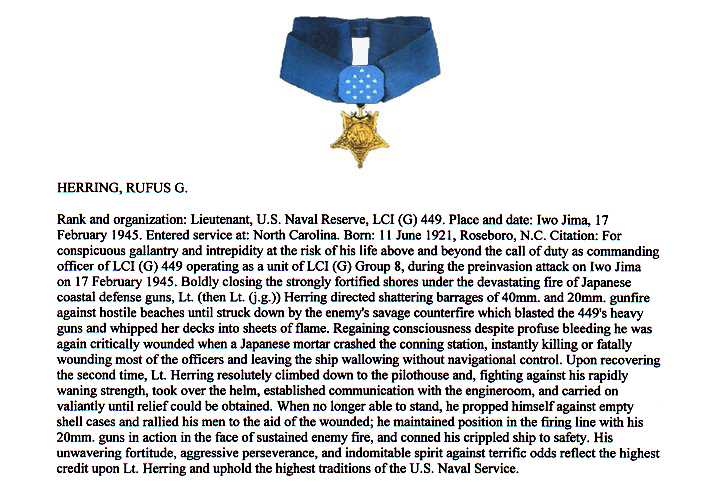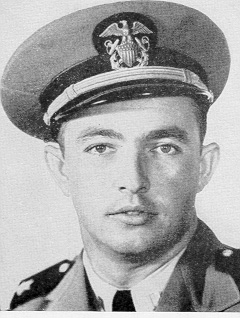HERRING-RUFUS
RUFUS GEDDIE HERRING

LCDR


The battle for Iwo Jima was the culmination of the U.S. Navy's "island-hopping" campaign across the central Pacific. The campaign began in November 1943 with the invasion of the Gilbert Islands at Tarawa and Makin. Over the next 15 months, the Navy captured Kwajalein and Eniwetok in the Marshall Islands; Saipan, Guam, and Tinian in the Marianas; and Peleliu in the Palau Islands. Iwo Jima, known as Japan's "unsinkable aircraft carrier," was probably the best defended island in the Pacific. Defended by over 20,000 veteran troops, the island's defenses included a wide variety of guns and mortars and more than 10 miles of underground tunnels linking hundreds of bunkers and blockhouses.
The reason the island was so heavily fortified was that Iwo Jima was a key component in Japan's air defense system. Located about 700 miles south of Tokyo, Iwo Jima possessed three airfields which were used by the Japanese Air Force to intercept American B-29 bombers on their 1,500 mile trip from Saipan to the Japanese mainland. If the United States captured Iwo Jima, it would severely damage Japan's air defense system, enable the Army Air Force to provide its B-29 bombers with fighter escorts all the way to Japan, and provide a valuable emergency landing site for damaged or malfunctioning American aircraft.
At about 10:30 a.m. on February 17, 1945, 12 LCI(G) gunboats began escorting a group of Underwater Demolition Teams (UDT) toward the beach. These UDTs were a key element in preparing for an amphibious assault such as Iwo Jima. They provided on-site reconnaissance such as checking beach and surf conditions, locating and destroying both underwater and beach obstacles, and collection beach and soil samples. Misinterpreting the LCIs as the main assault force, the Japanese opened fire on them at about 11 a.m. The gunboats returned fire with their rockets and 40-mm guns, but still took a beating over the next 45 minutes.
One of the ships involved in this action was LCI(G)-449, commanded by Lieutenant (then Lieutenant Junior Grade) Herring. The opening salvo by the Japanese destroyed the 40-mm gun on the bow and killed the five men manning it. Another projectile hit the conning tower and killed 12 men while a third shot hit the bridge. Herring, seriously wounded and barely conscious, struggled to his feet and took charge of his ship. He remained on station in the pilot house, propping himself up against some empty shell cases when he could no longer stand because of his wounds, and directed covering fire for the UDTs with the ship's remaining guns until relieved by LCI(G)-469. All told, the ship suffered 17 dead, 20 wounded, and all its guns were either damaged or destroyed.
- taken from Honor, Courage and Commitment: United States Naval Reserve Medal of Honor Recipients, Naval Historical Center

